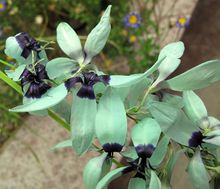Ixia viridiflora, also known as turquoise ixia, is a tall member of the genus Ixia. It comes from around the Tulbagh in South Africa, Cape Province.[1] It has small corms under the ground.
| Ixia viridiflora | |
|---|---|

| |
| Scientific classification | |
| Kingdom: | Plantae |
| Clade: | Tracheophytes |
| Clade: | Angiosperms |
| Clade: | Monocots |
| Order: | Asparagales |
| Family: | Iridaceae |
| Genus: | Ixia |
| Species: | I. viridiflora
|
| Binomial name | |
| Ixia viridiflora | |

This corn lily is very rare. Its habitats are often destroyed by human influence. As a consequence, its conservation status is vulnerable and is tending to worsen.
The name turquoise ixia refers to the blue-green turquoise colour of the flowers, which is a rare colour for flowers. They are grouped in long inflorescences and are normally star-shaped as in most corn lilies. The flowers have a black-purple centre. The ovary is 3-locular. The flower is pollinated by specific scarab beetles known as monkey beetles of the tribe Hopliini.
The turquoise ixia has good ornamental traits but it is rarely cultivated due to its conservation status.
References
edit- ^ Duncan, Graham (2003). "ENDANGERED GEOPHYTES OF THE CAPE FLORAL KINGDOM". Curtis's Botanical Magazine. 20 (4): 245–250. ISSN 1355-4905.
External links
edit- Data related to Ixia viridiflora at Wikispecies
- Media related to Ixia viridiflora at Wikimedia Commons